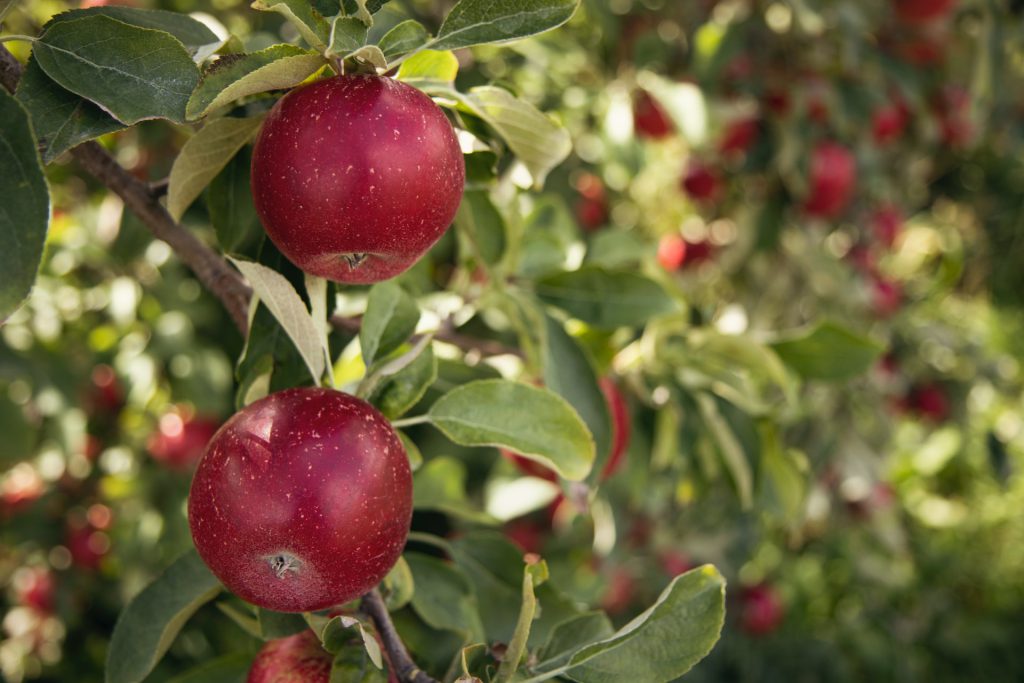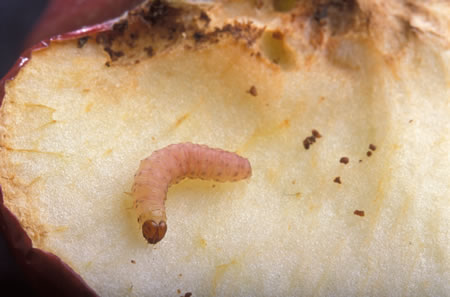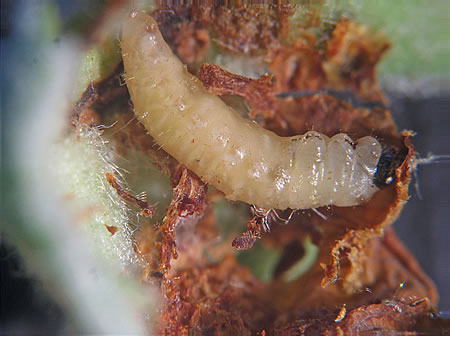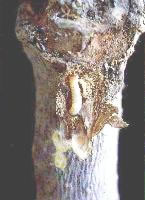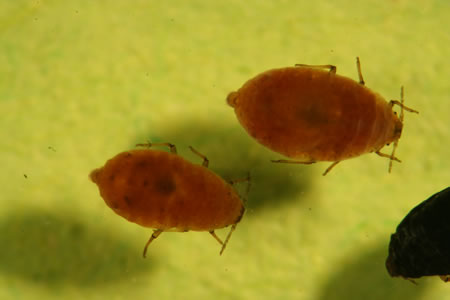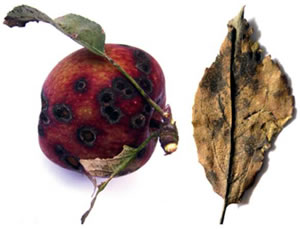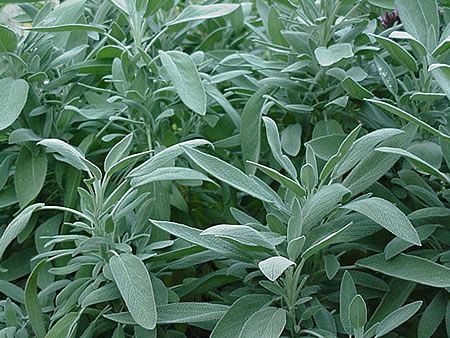Want to learn how to grow apple trees in the garden or in pots on the balcony in the city? A useful article about apple trees cultivation care, pests, diseases, nutrient deficiencies.
Apple cultivation, is the fourth most important crop after that of olives, citrus and peach. The apple tree has a rich root system, is deciduous and grows up to 5-12 meters high, blooms in spring with white flowers (initially pink) and its fruits (apples) ripen in autumn, with a diameter of 5-9 cm and rarely reaching 15 cm.
Figure 2. Apple blossom
The apple in humans diet, helps to burn fat, has very few calories and is good to be eaten after a meal because it contributes to the body’s metabolism and faster digestion.
Greek name: Μήλο, Μήλα (plural)
Latin name: Malus domestica, family Rosaceae.
Types and varieties of apples
Based on apple color
Depending on the apple color, we have the following varieties:
- Red apples: Red Delicious, Red Chief
- Yellow apples: Golden Delicious
- Green apples: Granny Smith and Firiki (Φιρίκι, Greek variety)
Based on ripening season
Depending on the ripening season, we have:
- Summer apples,
- September apples, which are Red Delicious and Golden Delicious
- Autumn apples, which are Granny Smith
For the Golden Delicious variety, a good pollinator is Red Delicious, while for Granny Smith a good pollinator is Golden Delicious and of course bees.
Climate and soil
Apple tree thrives in cool areas with good sunshine, does not tolerate climates with high temperatures (above 24 degrees Celsius), and requires low and stable temperatures in winter. Lowland areas are suitable for the production of yellow and green apples, while red apples are best cultivated in areas with higher altitude.
Apple tree prefers fertile and heavy soils, which drain well and are not high in calcium. Excess calcium causes food deficiencies in the tree. A pH of 6.2-6.8 is considered suitable for the growth of apple trees.
Planting apple trees
For someone who has a garden, apple trees can be planted either in a square shape or in rows with a spacing between trees of 4 – 4.5 meters.
In a square shape a suitable rootstock is Malling Merton 111, while for rows, suitable rootstocks are Malling 27 or 29 or 26 or Budagovsky 490.
Pruning apple trees
It is done in winter, before the beginning of new growth. Remove the diseased or small branches and keep the strongest ones, which will also yield new shoots in the spring. Old and weak trees are pruned severely, while young trees are pruned more lightly.
Tip: in case the tree bears a lot of fruits, thinning is needed after June, either by hand or with a chemical, but it is better by hand.
Irrigation of apple trees
The apple tree tolerates soil moisture but also requires it, especially during the summer months. It needs about 1000 mm of water per year. Half of the amount needed throughout the year, i.e. 500 mm, is consumed in July and August. If the soil in the pot is light-sandy, it should be watered more sparingly. In general, the apple tree also “stores” water for the next growing season. Water 1-2 times a week.
For those of you who have a garden, it is favorable to make a mound around the base of the trunk, at a distance of 50 cm. Also, if you have 2 – 3 trees in a row, you can make 2-3 grooves parallel and between the trees. Where there is the possibility for artificial rain is the best, since we get better water distribution.
Tip: Drip irrigation may be less expensive but it increases the concentration of salts in the soil and apple trees are sensitive to salts.
Growing apple trees in pots in the city
Red Spour is the most popular variety of apple trees for growing in pots. It blooms with lightly scented flowers in May to June and sets fruits in September to October. The pot should be large enough, 50 cm * 50 cm * 50 cm. The volume of the pot is 125 liters and the height of the tree will reach up to 1.50 meters. The area of the pot is 0.25 square meters, so the nitrogen needed for this area is 6.25 grams before flowering, around March, while the amount of phosphorus is at 1.25 grams. The fertilizer is first spread over the entire surface of the pot and then spread 3-4 cm and 5-7 cm from the trunk of the tree.
Tip: Phosphorus and potassium are incorporated at a depth of 15-20 cm.
Fertilization of apple trees
Nitrogen fertilization is applied to the apple tree every year, potassium fertilizer is applied every year or every two years, while phosphorus fertilizer is never applied or applied very thinly. The other elements, Fe, Mg, Mn, Zn, B are applied when there are deficiencies.
Nitrogen is necessary from the end of March until the end of summer, when fertilization is done through irrigation water. On hot days, no fertilization is applied. Fertilizer should be applied not only around the trunk of the tree but also a little further away, since the roots grow almost 1.5 times the height of the tree. A suitable fertilizer for apple trees is the granular organic fertilizer POKON, which provides nutrients and also helps the fruits.
A rule of fertilization application to the apple tree, based on age, is the following:
| Tree age (years) | Nitrogen (N) | Phosphorus (P) | Potassium (K) |
|---|---|---|---|
| 1 | 24 gr | – | – |
| 2 | 24 gr | 5 gr | 30 gr. |
| 3 | 48 g. | 10 gr | 60 gr |
| 4 | 72 gr | 20 gr. | 60 gr |
| 5 | 98 gr | 20 gr | 120 g. |
Tip: Potassium contributes to the quality of the fruit. In light soils it is preferable to use potassium sulphate, while in heavy soils potassium nitrate is preferable.
Common nutrient deficiencies of apple trees
The common nutrient deficiencies of apple trees are:
Iron deficiency
1) Iron deficiency (Fe), where the characteristic feature is the midvein chlorosis on the leaves.
Figure 3. Iron deficiency in apple leaves
It is relatively easily corrected by applying Ferrous Sulfate ( FeSO4) to the soil or in a chelated iron form such as Sequestren.
Zinc deficiency
2) Zinc deficiency ( Zn), characterized by small leaves, small fruits and drop of leaves on shoots. Spray the tree with 3-5% ZnSO4 in the winter period before pruning or apply chelated iron to the soil.
Boron deficiency
3) Boron deficiency (B), the symptoms of boron deficiency are particularly evident on the fruit in the form of splitting and cork-like spots. The leaves are sometimes excessively thick and brittle.
Figure 4. Boron deficiency inside the apple
Manganese deficiency
4) Manganese deficiency (Mn), the case of manganese deficiency is mainly treated by translaminar spraying with 1% manganese sulfate or chemical forms of the element. Chemical formulations should be used very early in the spring or after the petals have fallen.
Figure 5. Manganese deficiency in apple fruits
Magnesium deficiency
5) Magnesium deficiency (Mg), magnesium deficiency causes necrosis in mature and developed leaves with brown or black color and leads to leaf loss.
Figure 6. Magnesium deficiency on the underside of an apple leaf
Apple tree pests
Although grown all over the world, the apple tree has acquired many pests and diseases that cause damage to both the fruit and other parts of the tree.
Codling moth (Cydia pomonella)
Codling moth or apple worm, causes great damage to the fruit, the larva feeds on the inside of the fruit and eventually destroys it. It is the most serious pest of apples and affected fruit either fall prematurely or are unfit for eating.
Figure 7. Codling moth larvae emerging from the fruit after it has done its damage
Figure 8. Adult codling moth
Control of Codling moth: Codling moth adults first appear in April-May and again after July.
For chemical control, winter spraying of trees with mineral oil fortified with dinitrocresol or water soluble dinitrocresol formulations is recommended.
Suitable agricultural insecticides for the control of fruit fly are:
Laser 48 SC: a trans-systemic insecticide acting on the insect nervous system with a suppressive property. It is applied by spraying the foliage at the appearance of the first insects. The quantity for one apple tree is 0.2-0.3 ml/litre of water. Repeat after 7-14 days and use up to 3 times maximum during the growing season.
Calypso 180 OD and Calypso 48 SC: intersystemic insecticides with preventive and suppressive action. Because they belong to the same group of insecticides, they are never used at the same time or on the same crop. To apply Calypso 180 OD, dissolve 0.5-0.65 ml in 1 litre of water and spray. It can be used up to a maximum of 2 times with an application interval of 14-21 days. Calypso 48 SC is applied as follows: 0.2 ml/litre of water and repeated after 14 days. It can be applied up to 3 times to the crop.
Onore 240 SC: at the appearance of the first infestations, dissolve 0.4 ml in 1 liter of water and spray the leaves of the tree. It can be applied again after 14-21 days.
Runner 240 SC: exactly the same as Onore 240 SC. Caution: the latter two should not be used when the insecticide Mimic has already been applied to the crop, due to the fact that they contain the same active substance.
Steward 30 WG: insecticide which acts on all stages of insect development and the insects stop all movement and food intake and are killed within 24-60 hours. It is applied up to 3 times, with an interval of 10-14 days between applications and the quantity is 0.165 ml/lt of water for each tree.
Affirm 095 SG: it is a non-disystemic insecticide, the insects ingest it, paralyse and eventually die. Dissolve 2-2.5 ml in a litre of water and spray. Apply up to 3 times on our tree.
A suitable carbamate is Methomyl, which, in addition to the larvae, also kills the insect embryos.
Pyrethroids that can be used on apple trees are: Bifenthrin, L- cyalothrin, Cyfluthrin, Fenpropathrin, Flucithrinate and Fluvalinate. Caution: pyrethroids should not be used more than twice a year. All of the above insecticides also kill adult insect individuals.
Inhibitors used against the fruit fly are Diflubenzuron, Fenoxycarb, Hexaflumuron, Teflubenzuron and Triflumuron. These substances kill both eggs and larvae of the insect, except for Fenoxycarb which acts mainly as an ovicidal agent.
Also, if we have 3-4 apple trees in our garden, we can make use of traps, which contain pheromone (insect attractant) and prevent coupling. We hang a trap on a 2 cm thick branch about 1/3 of the height of the tree. The traps are applied as soon as the first insects appear and repeated once more at 150 days. Such a formulation is Checkmate CM-XL.
For biological control there are the formulations Carpovirusine, Decyde, Granupom, Madex and Virin- Gyap. These formulations contain granulosis virus (GV) and have satisfactorily controlled fruit fly on apple and pear trees in several European countries. Any larvae that eat a sprayed plant surface die in about 48 hours. Two sprays, 12-15 days apart, are usually needed.
Rosy apple aphid (Dysaphis plantaginea)
The rosy apple aphid attacks mainly apple trees and secondarily quince. It occurs several times a year and is found on the underside of the leaves. It causes leaf deformation and secretes toxins that cause fruit deformation.
Figure 9. Adult individual of rosy apple aphid
For chemical control are proposed:
Actara 25 WG: insecticide applied by spraying on the leaves or watering the roots. Spraying should not be done during the hot hours of the day or when rain is expected in the next 4 hours. The duration of protection is 21 days for foliar spray and 30-45 days for ground application. It is applied 1-2 times per growing season and the rate is 0.2-0.25 ml/lt of water.
Calypso 180 OD and Calypso 48 SC, mentioned above, are also suitable for aphids, at exactly the same dosage.
Dantop 50 WG is applied once a year, 0.15 ml/lt of water and spray the leaves when the fruit has reached about 70% of its final size. It should not be applied when bees are observed near our apple tree to be highly mobile, when the apple tree is about to flower and when there are 4 aphids or more on each leaf. If one has a small apple orchard, after spraying, one should not go near the sprayed area for 48 hours.
For biological control there are natural enemies of aphids, such as the ladybird and the predator Orius sp.
Spotted tentiform leafminer (Phyllonorycter blancardella)
Spotted tentiform leafminer causes damage to leaves and apart from apple trees, it attacks pear and quince trees.
Figure 10. Adult of the spotted tentiform leafminer
Figure 11. Spotted tentiform leafminer affected leaf
Chemical control is recommended:
Calypso 48 SC, at 0.2 ml/lt of water.
Calypso 48 SC, with 0.2-0.3 ml/lt of water and spray on the leaves.
Onore 240 SC and Runner 240 SC, applied exactly the same as in the wrist cap, same amount, same application interval.
Formulations: Karate Zeon 10 CS, Kusti 2,5 WG, Sentinel 2,5 WG. These all belong to the pyrethrin group and are exclusively for the treatment of spotted tentiform leafminer. They are applied when the first infestations are observed and the dosage is 0.1 ml/lt, 0.4 ml/lt and 0.4 ml/lt respectively
The formulations: Mospilan 20 SP and Profil 20 SG. They belong to the same category, we spray the leaves, their duration of action is 14-21 days and the quantity for both is 0.25-0.375 ml/lt of water per tree.
Apple blossom weevil (Anthonomus pomorum)
Apple blossom weevil also attacks pear trees in addition to apple trees but to a lesser extent. It causes serious damage when its population is large, where it eats the flowers and can negate fruit set.
Figure 12. Individual of apple blossom weevil
Figure 13. Apple blossom weevil larva in flower
For chemical control, an organic synthetic insecticide is used, which is generally sufficient. If the weather is cold, a re-spray may be needed 1-2 weeks later.
Wood-eating insects – Clearwing moths (Sesiidae), Goat moth (Cossus cossus), Leopard moth (Zeuzera pyrina)
The wood-eating insects that damage the apple tree are the Clearwing moths, the Goat moth and the Leopard moth. Their larvae open holes in the trunk and branches of the trees. The tree parts become weak and break.
Figure 14. Adult female of the clearwing moth
Figure 15. Larvae of clearwing moth
The control of clearwing moth is quite difficult, due to the increased population, many sprays are required to kill the insect. Sprays are made on the trunk and arms of the apple tree, approximately every 3 weeks, with organophosphorus insecticides containing the active substance Chlorpyrifos, starting in May. If the tree is up to 1.5 meters high, we can spray the trunk with a mixture of summer mineral oil and parathion or apply a brush dipped in car oil in the first half of November. This intervention acts preventively for the following year.
Figure 16. Adult of goat moth
Figure 17. The larva of the goat moth is distinctive because of its colors
The presence of the larva is betrayed by its reddish exudates, which gather as a powder at the base of the trunk.
For chemical control there is a winter pulp, Nitrofarm, where the larva is actually fought against. If you have applied sulphur or calcium sulfide, winter oil should not be applied 30 days before and after sulphur. The dosage is 15-20 ml/lt of water and spray the trunk and branches from dormancy until before buds swell.
The last wood-eating insect is the leopard moth, which attacks both pear and olive trees. It is a serious pest of apple trees and a single larva can dry out a 3-year-old tree. On older trees, whole arms dry up.
Figure 18. Adult of the leopard moth
Figure 19. Leopard moth larvae inside a stem
As a preventive measure, we can do the following: to spray the trunk and branches in the summer with organophosphorus insecticides, every 15 days, from the beginning of June to the middle of August. It is also recommended to whitewash the trunk and branches where it significantly reduces the multiplication of eggs. Finally, there are anti-fungal matches that release suffocating gas to block the tunnels or use clay or some other material.
For chemical control, spraying with a mixture of 750 ml of water, 250 ml of emulsifiable polybutane and 1 gram of Chlorpyrifos is effective. The emergence of brown liquid from the lodge indicates that the larva has been killed.
For biological control, cotton wicks soaked in an aqueous suspension containing the insect-pathogenic nematode Steinernema carpocapsae can be introduced into each lodge.
Apple ermine (Yponomeuta malinellus)
The apple ermine mainly attacks apple trees. The damage is done by the larvae, which move en masse and emerge in mid-April.
Figure 20. Adult of the apple ermine
Figure 21. Nest with apple ermine larvae at the top of an apple shoot
For biological control of the apple ermine there is the insecticide Bactecin 0.2 DP, which acts against the larvae. It is not to be combined with any other substance. It is applied on the leaves of the apple tree and for a 10 m2 garden a total of 18-22 grams of powder is required.
Apple leaf miner (Lyonetia clerkella)
Apple leaf miner is a small butterfly that is 10-16 cm long. It attacks apple and cherry trees. It is active in spring, when the first leaves of the apple tree develop and the hole is initially yellow and then brown.
Figure 22. Adult of the apple leaf miner
Figure 23. Larva’s tunnel of an apple leaf miner in an apple leaf
For chemical control, suitable formulations are Calypso 180 OD and Calypso 48 SC (see Codling moth (Cydia pomonella)).
Wooly apple aphid (Eriosoma lanigerum)
The wooly apple aphid attacks shoots, branches, trunk and roots up to 25 cm.
Figure 24. Adult individuals of the wooly apple aphid
Figure 25. Colony of the wooly apple aphid insect on an apple tree arm
For chemical control and indeed suitable for amateur use is Admiral 10 EC. Spray the leaves, before flowering, after dissolving 0.3 ml in a liter of water. Before spraying, the branches and the base of the trunk must be soaked, so we water.
For biological control in recent years, the aphid Aphelinus mali has been introduced, which is a natural enemy of wooly apple aphid and reduces its population to tolerable levels.
Diseases of apple trees
Apple scab (caused by Venturia inaequalis)
Apple scab of the apple tree is the most dangerous disease of the apple tree. It attacks fruits and leaves. The bark of the fruit becomes dead and eventually deformed. Varieties resistant to apple scab are Prima and Priscilla.
Figure 26. Symptoms on apple fruit of the fungus apple scab
Figure 27. Scales on apple leaf from apple scab fungus attack
For chemical control suitable are the following:
Bellis WG, which is a fungicide with preventive and curative action. Its dosage is 0.5-0.8 grams per liter of water per tree. It can be used up to a maximum of 3 times during the growing season.
Flint Plus: spray the leaves, dissolve 0.125 grams in one liter of water and the maximum number of applications is 2 with an interval of 8 days. The active substances it contains are likely to cause an allergic reaction. After spraying your tree, do not approach it for 48 hours.
Delan 50 SC and Delan 70 WG formulations: act protectively and therapeutically on apple scab. They do not break down easily and are therefore applied in small doses. In particular, before flowering we dissolve 1.2 ml/liter of water Delan 50 SC and spray the leaves and after flowering dissolve 0.75 ml/liter of water. Delan 70 WG is used as follows: before flowering, spray 0.8 grams in 1 liter of water and after flowering 0.5 grams in 1 liter of water.
Maccani WG: apply by spraying the foliage, at a dosage of 1.25-2.5 grams/liter. Maximum number of applications: 3.
Stroby 50 WG: its effectiveness is not affected by possible rainfall for 2 hours after application. 0.2 grams of fungicide are required for a 10 m2 garden, where we spray the leaves. It can be applied up to 4 times with an interval of 12-14 days
Systhane 12 EC, Systhane 20 EW, Systhane 24 EC, Systhane 4,5 EW, Systhane 6 SC: fungicides with protective and curative action. A low dose is applied preventively and a high dose is applied therapeutically.
Powdery mildew of apples and pears (caused by Podosphaera leucotricha)
Powdery mildew of apples attacks leaves and shoots but is a problem for some varieties such as Jonathan, Rome Beauty, Baldwin and others.
Figure 28. Powdery mildew of apples on an apple leaf
Figure 29. Powdery mildew of apples on an apple fruit
For chemical control there are:
Fluidosoufre 99 DP: it is in powder form, the suitable temperature is above 20 degrees Celsius and at a temperature above 28 degrees Celsius, the trees show burns. In a 10 square meters garden, 20 to 35 grams of powder are needed, which is spread on the leaves. The application of the drug starts from flowering until the beginning of June, every 10-12 days. For a pot of large diameter, 2-3 grams of powder are needed.
For spraying the foliage, Bellis WG (see Fusicladium) is suitable. and Nimrod 25 EC: 0.4-0.6 ml/lt water, up to 3 times can be applied 14 days apart. Under no circumstances should the dosage be exceeded.
Shavit- F 70/1,5 WP and Shavit- F 70/2 WG: 2 g per liter of water, as a preventive measure, up to 3 times in the growing season and spray the leaves.
Fire blight of apple tree (caused by Erwinia amylovora)
Fire blight of apple tree attacks apple, pear and quince trees. The fruits show brown to black rot and the flowers wither and eventually dry out.
Figure 30. Apple tree severely affected by fire blight of apple tree
Figure 31. Apple fruit and leaf affected by fire blight of apple tree
For chemical control recommended:
Foliar sprays with Blossom Protect. To increase effectiveness, combine with substances that reduce the pH of the spray solution. The dosage is 1.5 gram/liter of water and spray when our tree has reached 10%, 40%, 70% and 90% of flowering
Vacciplant SL: the substance activates the apple tree’s self-defenses. As a preventive measure, 0.75 ml/liter of water, every 10 days, up to 7 times during the growing season.
Check 50 WG, Check 50 WP: 2.5 g/liter of water, at the beginning and end of leaf fall. It should be used before flowering and some varieties such as Golden delicious, Jonathan, Renneta and Staimon are susceptible when the formulation is applied after the onset of germination.
Cultivation calendar of apple trees
Winter: November-December-January-early February
Prune in moderation and with the aim of lighting the trees, remove shoots affected by either insect or fungus, check for weeds and spray with insecticide (oil and pyrethrin).
Spring & Summer start: April-May-June
Apply nitrogen, half of the needed amount, check leaves for fungus, insects and soil for weeds.
Spring end and Summer middle: May-June-July
Irrigation, fruit thinning, control of fungi and diseases, supplemental nitrogen fertilization and summer pruning.
Summer end and Autumn: August-September-October
Control of diseases and insects, application of nitrogen by foliar spraying, irrigation if necessary.
Agronomist Sophia Papazoglou
Agronomist MSc “Environmental Management”
Photo by Jen Theodore on Unsplash
Tags: APPLE TREE • APPLE TREES • APPLES • DEFICIENCIES • DISEASES • ENEMIES • FERTILIZATION • GARDEN • INSTRUCTIONS • POT • PRUNING • TIPS • TREE

